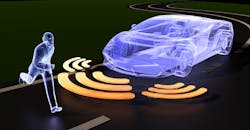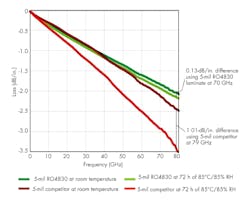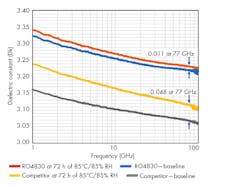Circuit Materials Secure Automotive Safety Systems
Download this article in PDF format.
Electronic safety systems are rapidly becoming major parts of modern automotive vehicles, steering toward a future of roadways filled with autonomous vehicles. Advanced driver-assistance systems (ADAS) based on radar and electronic communications circuits are promising safer future roadways. Crafting these systems requires high-frequency electronic components, such as RF/microwave printed-circuit-board (PCB) antennas for automotive radar sensors and for various forms of communications between vehicles. In turn, fabricating effective components requires suitable circuit materials.
Increased reliance on high-frequency electronics can help pave safer roadways for the future. At present, more than 1.25 million automobile-related deaths occur each year globally, with another 50 million people injured. Improving traffic safety is a key motivation for expanding the ADAS functions of vehicles.
New Car Assessment Program (NCAP) organizations in several countries and regions have established car safety roadmaps, challenging automobile manufacturers to improve safety functions to earn NCAP top vehicle safety ratings. Mobility as a Service (MaaS) is also emerging as a market to provide consumers affordable transportation options versus personal vehicle ownership, which also frees passengers to convert their driving time to higher value activities.
ADAS systems such as millimeter-wave (mmWave) radar sensors help to improve the safety of commercial automotive vehicles and, as such, are graded by the Society of Automotive Engineers (SAE) in terms of six levels of vehicle autonomy, from Level 0 (no automation) to Level 5 (full automation). Many organizations focused on increasing vehicle safety approach vehicle automation from the ground (Level 0) up, while organizations interested in developing autonomous vehicles have great interest in Level 4 or 5 automation, where a driver becomes more of a passenger.
Whatever the level of vehicle safety required, multiple sensors are needed for a reliable, full 360-deg. view of a vehicle’s environment. Electronic devices contributing to that full view include light detection and ranging (LiDAR) sensors, cameras, radar, Global Positioning System (GPS) receivers, and vehicle-to-everything (V2X) communications systems. Radar sensors are important ADAS components since they can measure the distance, velocity, and angular position of targets near a vehicle.
Automotive radar sensors are currently designed at two operating frequencies: 24 and 77 GHz. While the ultrawideband 24-GHz allocation (21.65 to 26.65 GHz) will no longer be available in the U. S. and Europe by 2022, narrowband 24-GHz (24.05 to 24.25 GHz) vehicle radar will continue to be available. The 77-GHz band extends from 76 to 81 GHz.
Radar sensors at 24 GHz are typically used for short- and mid-range functions such as rear blind-spot detection and rear cross-traffic alert. Shorter-wavelength 77-GHz radar sensors can be employed for short-, mid-, and long-range target detection. Some long-range functions include adaptive cruise control and automatic emergency breaking. To achieve higher levels of safety and autonomous functions, 77-GHz radar requirements will increase and evolve from their current uses for object detection to object discrimination and imaging. Greater reliance on 77-GHz radar systems will require increased distance detection, distance resolution, and elevation measurements.
Circuit Materials
Automotive radar sensors at 24 and 77 GHz rely on high-performance circuit laminates for reliable PCB antennas at such high frequencies. Antenna frequencies and specific performance goals will determine the circuit material requirements. An RF/microwave circuit designer must balance the tradeoffs of circuit material properties with other antenna components to find the most cost-effective circuit material solution for a PCB antenna design. For example, there are four key circuit material properties to consider for a 77-GHz automotive radar antenna: the dielectric constant and its tolerance, the insertion loss, the electrical stability of the material, and the homogeneity of the substrate material.
Signal wavelengths decrease with increasing frequencies, requiring very fine circuit features for 77-GHz PCB antennas. Because circuit substrate materials with higher dielectric-constant (Dk) values can also result in smaller circuit features for a given frequency/wavelength, circuit materials with lower Dk values, such as 3.0 (based on measurements using IPC TM-650 2.5.5.5 at 10 GHz), are often used for circuits at mmWave frequencies. Stable Dk performance is necessary, both for good performance from an individual PCB antenna and for consistent antenna-to-antenna performance over the typical time of a 10- to 15-year program. Therefore, circuit material with carefully controlled dielectric constant within a tolerance of ±0.05 or better (based on IPC TM-650 2.5.5.5 at 10 GHz) is desired.
High PCB radar antenna gain aids in distance detection, and PCB radar antenna gain is optimized using circuit materials with low insertion loss. The insertion loss of a circuit laminate consists of the material’s dissipation factor (Df) and copper foil surface roughness. The Df depends on the substrate material; PTFE-based laminates tend to have a lower Df compared to other substrate resin systems, such as hydrocarbon thermosets.
At mmWave frequencies, thin RF laminate core thicknesses of 0.010 in. or less are often used, and the copper-foil surface roughness will have a more significant impact on the overall insertion loss as compared to thicker (for example, greater than 0.030 in. thick) RF laminates. Rolled copper foil has the lowest copper-foil root-mean-square (RMS) roughness (Rq) at 0.4 µm.
Circuit laminates are available with electrodeposited (ED) copper foils with varying levels of surface roughness, typically costing less than laminates with rolled copper. However, surface roughness and electrical performance must be balanced with other properties, such as copper adhesion strength to the dielectric substrate through thermal exposures.
1. The plots of insertion loss versus frequency compare RO3003 and RO4830 circuit laminates with different copper-foil options.
RO3003 and RO4830 circuit laminates from Rogers Corp. represent examples of how circuit laminate Df and copper surface roughness can be selected for low overall circuit laminate insertion loss. As a ceramic-filled PTFE resin system, RO3003 laminates have a low Df of 0.0010 at 10 GHz. Pairing 5-mil-thick RO3003 substrate with different copper foils that have different copper-foil surface roughnesses will result in different insertion loss values (see Fig. 1 and the table).
For example, with rolled copper, RO3003 laminates exhibit microstrip transmission-line insertion loss of 0.9 dB/in. at 77 GHz (using a microstrip differential phase length test method). When using very-low-profile (VLP) ED copper foil with a copper surface roughness of 0.7 µm, RO3003 laminate has insertion loss of 1.3 dB/in.
In contrast, RO4830 circuit laminates, which are based on a hydrocarbon thermoset resin system, have a Df of 0.033 (at 10 GHz), significantly higher than the Df of RO3003 laminate. However, when paired with a reverse-treated ED copper foil with Rq roughness of 0.9 µm, the insertion loss of a 5-mil-thick RO4830 laminate is 2.2 dB/in., which is quite close to the insertion loss value of RO3003 laminate with a standard ED copper foil that has roughness of 2.0 µm (Fig. 2).
2. The insertion loss of microstrip transmission lines is compared (by differential length method) for 5-mil-thick RO4830 circuit laminate and a competitive 5-mil-thick thermoset circuit material.
In use, automotive radar sensors will encounter a wide range of environmental conditions that can impact antenna performance. For stability, an antenna can be protected by a suitable enclosure, which will add to cost, or be fabricated on a circuit laminate that provides high stability under the expected operating conditions.
The environmental stability of a circuit laminate can be gauged by checking its thermal coefficient of dielectric constant (TCDK), which is how much the dielectric constant varies over a wide temperature range, and by measuring Dk and Df in a hot, humid environment. One rule of thumb is that a TCDK target of│50│ppm/°C or better for TCDK is appropriate for RF laminates used for automotive radar applications. Figure 3 plots insertion loss and Dk for two circuit laminates after the materials spent 72 hours at +85°C and 85% relative humidity (RH).
3. The Dk versus frequency is plotted for RO4830 circuit laminate and a competitive circuit material under different operating environments.
For insertion loss, the two green trend lines compare measurements of 5-mil-thick RO4830 circuit laminates taken at room temperature and taken after environmental exposure. The difference in loss is small for the RO4830 circuit material under different conditions, especially when compared to another thermoset circuit laminate (the red lines), which reveal a difference of 1 dB/in. at 77 GHz.
For Dk, as Fig. 3 shows, the Dk of RO4830 circuit laminate increases by about 0.011 after exposure to the +85°C/85% RH conditions. This is not as significant as the 0.048 increase in Dk exhibited by the alternative thermoset circuit material for those same +85°C/85% RH conditions. Considering that the Dk is held to a tolerance of ±0.05 for these materials, a change of 0.048 in Dk is one-half of the expected Dk tolerance, and it may be a variation in Dk value that is not accounted for in an antenna design.
Homogeneous Substrates
Stable electrical performance is an important circuit material property whether evaluating one antenna or many. Circuit laminates with homogeneous composition support uniform electrical properties on a small scale, especially at short wavelengths at 77 GHz.
RO3003 laminate is an example of a homogeneous circuit material. It’s comprised of a uniform layer of ceramic-filled PTFE, with no glass fabric. Sometimes RF circuit laminates containing woven glass fabric are desired for their mechanical properties through PCB fabrication. For those cases, it’s helpful to use a ceramic-filled RF circuit laminate that contains a spread-weave woven-glass fabric.
A standard weave glass has “windows” between the warp and weave bundles (like a loosely knit sweater). As a transmission line moves across the laminate, it will alternate between being above a glass bundle (in which glass has a Dk of about 6) and a resin-rich, glass-poor bundle (where the resin has a Dk between 2 and 3). The glass fibers in each direction of a spread-weave glass fabric are modified to minimize that window effect and create a more uniform consistency of glass fabric in the x-y plane. RO4830 laminate is one example of a ceramic-filled RF circuit laminate with Dk of 3 and spread glass.
Communications Antennas
To facilitate ADAS and autonomous vehicle functions, a vehicle’s electronic systems must also gather information about its exact position, about the locations and velocities of vehicles outside its line of site (LOS), and about pertinent road conditions. Global Navigation Satellite System (GNSS) antennas and V2X antennas help achieve these goals. However, integrating an increasing number of communications antennas within a vehicle poses numerous challenges, since space is limited and aesthetics may favor antennas concealed behind fascia rather than combined in a traditional shark fin.
GNSS antennas are already commonly used in modern vehicles, but they will become increasingly important for ADAS and autonomous-vehicle functions to determine more precisely the position of the vehicle. Various GNSS systems around the world employ frequency bands from about 1.1 to 1.6 GHz, with ceramic and FR-4-based circuit materials commonly used for GNSS PCB antennas.
But as GNSS antennas with greater accuracy are required, circuit materials with much more stable material properties, such as lower insertion loss, tighter dielectric thickness tolerance, and tighter control of Dk, will become more critical. Such enhanced-performance GNSS antennas may be candidates for circuit materials like high-performance FR-4 or Kappa 438 circuit laminates from Rogers Corp.
As part of electronic safety systems, vehicles are expected to communicate with each other by means of vehicle-to-vehicle (V2V) and vehicle-to-infrastructure (V2I) systems, as well as vehicle-to-networks (V2N). V2V systems enable a vehicle to know that a vehicle two or three car lengths ahead and out of sight has just stopped, allowing the current vehicle to slow down and avoid a collision. V2I could enable the vehicle to communicate with infrastructure equipment at an intersection to let the vehicle know that a light will turn red or another vehicle is approaching from a blind alley. Downloads of high-resolution maps, software updates, and even downloads of entertainment content may be enabled by V2N wireless connections.
V2V communications will occur at 5.9 GHz. Significant investments have been made in the U.S. in recent years to develop dedicated short-range communication (DSRC) safety applications based on IEEE 802.11p standards. In Europe, the European Telecommunications Standards Institute (ETSI) has also supported ITS-G5, which uses the same protocol. In recent years, with the anticipation of 5G wireless cellular communications networks, a competing cellular V2X, or C-V2X protocol, has been developed to also support V2V communications.
Since the governmental organizations in the U.S. and Europe are not expected to mandate a specific technology protocol for V2V applications, it may be up to individual automotive original equipment manufacturers (OEMs) or OEM consortiums to choose a V2V technology. Likely, the communications protocol will not significantly affect the antenna hardware design.
Antenna performance requirements will drive circuit-material performance requirements, which may also be affected by available locations within each vehicle for antenna placement and by coverage requirements. If FR-4 circuit materials cannot provide the performance levels needed for V2V PCB antennas, a variety of high-frequency commercial circuit materials may be candidates, such as RO4000 Series or AD Series laminates from Rogers Corp., available with different Dk values.
Joey Keller is Market Segment Manager at Rogers Corp.





